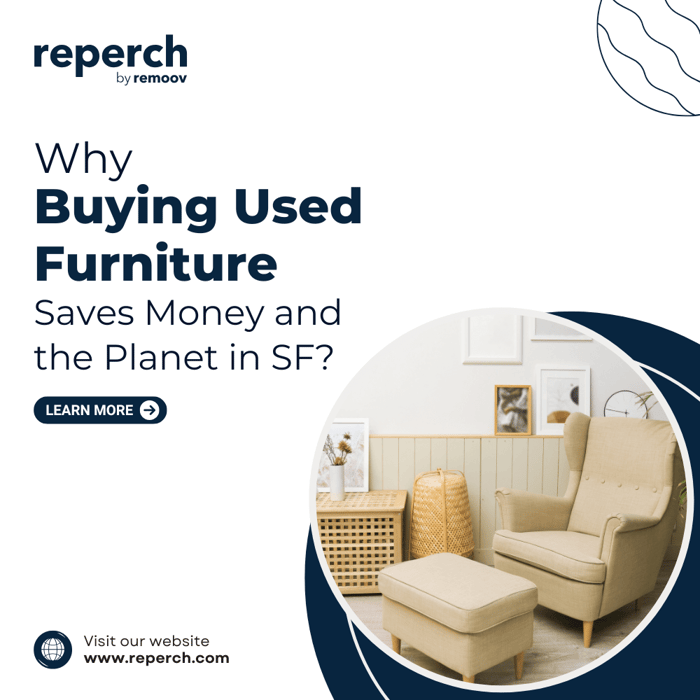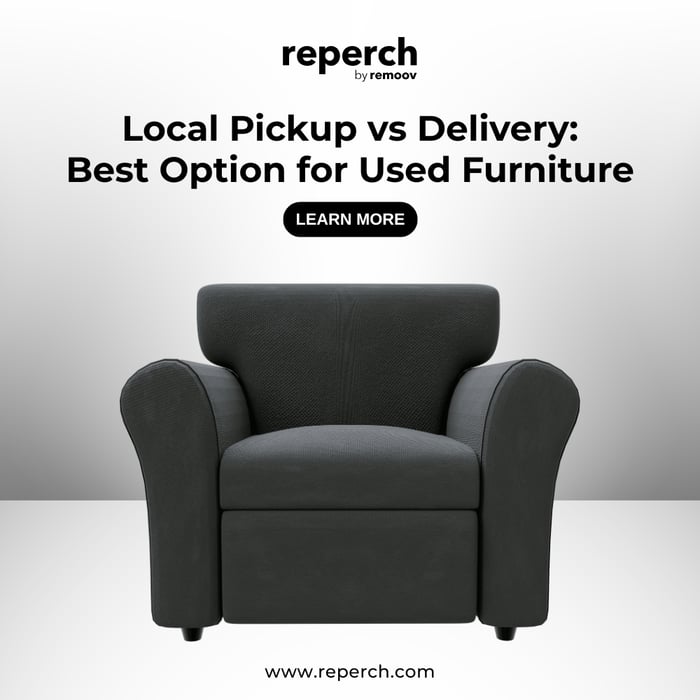San Francisco living ranks among the most expensive in the country. From rent to parking to coffee prices, every dollar counts. Furnishing a studio or a six‑bedroom Edwardian can feel like one more high ticket line item on an already stretched budget. What many residents overlook is the power of the secondhand market to solve two problems at once: keeping more money in your pocket and keeping usable goods out of Bay Area landfills.
This guide explains exactly how buying used furniture delivers both financial relief and environmental gains. Along the way, you will find local statistics, real savings examples, and straightforward shopping tips that make the process simple.
The Hidden Price Tag on New Furniture
The showroom gloss of a brand‑new sectional hides more than the sticker price.
Production emissions
The International Energy Agency estimates that global furniture manufacturing releases nearly one hundred million metric tons of carbon dioxide each year. Wood harvesting, metal casting, synthetic fabric production, and transoceanic shipping all contribute.Resource consumption
Fresh timber, foam derived from petroleum, and mining for metal hardware deplete natural reserves. Each new dining table represents trees felled, oil refined, and ore extracted.Retail markups
Traditional furniture can carry margins of two hundred percent or more. Shipping delays and warehouse overhead push prices higher, especially in coastal cities like San Francisco.Short lifespans
Flat‑pack pieces built from particleboard rarely survive more than one or two moves. When the back panel warps or the cam bolts strip, the item heads to the curb.
These hidden costs do not appear on a receipt, yet they affect both your wallet and the climate.
The Financial Upside of Going Secondhand
Dramatic Price Drops
A quick check of recent Reperch sales shows the power of depreciation:
West Elm Harmony Sofa
Retail $2,199
Reperch Price $795CB2 Stax Dining Table
Retail $699
Reperch Price $275Article Burrard Armchair
Retail $599
Reperch Price $210
Savings hover between fifty and seventy percent, sometimes more when a motivated seller needs space fast.
Better Materials for Less
Older solid‑wood dressers, crafted before the rise of engineered board, often sell for the same price as new lightweight varieties made from veneer over fiberboard. The secondhand shopper ends up with dovetail joints and hardwood runners without paying artisan premiums.
Lower Delivery Fees
Local delivery inside San Francisco through Reperch costs a flat rate well below prices quoted by national freight carriers. Many buyers discover that professional delivery beats the combined expense of van rental, tolls, and time off work.
Environmental Wins That Start at Home
Landfill Diversion
The Environmental Protection Agency reports that Americans throw out more than twelve million tons of furniture each year. The Bay Area diverts a higher percentage of waste than most regions, yet bulky items still crowd local disposal sites. Every sofa reused through the secondhand market prevents an estimated ninety kilograms of landfill waste.
Carbon Reduction
Manufacturing a new wooden coffee table emits approximately forty kilograms of carbon dioxide, while extending the life of an existing table produces almost none. Multiply that by every household that chooses used over new and the emission cuts scale quickly.
Resource Conservation
Buying secondhand slows demand for virgin timber, synthetic foam, and metal fasteners. This helps preserve forests like those in the Pacific Northwest and reduces extraction pressures abroad.
Lower Off‑Gassing
Freshly produced furniture often releases volatile organic compounds for months after unpacking. Preowned pieces have already completed most of this off‑gassing phase, improving indoor air quality for sensitive residents.
More Than Money: Quality, Character, Story
Time Tested Construction
Furniture built a decade ago or earlier tends to feature thicker hardwood frames, solid drawer bottoms, and tighter joinery. Manufacturers then relied less on cost cutting with thin veneers. Sitting on a vintage teak chair quickly reveals the difference.
One‑of‑a‑Kind Style
The preowned market teems with midcentury silhouettes, industrial metal bases, and handmade artisan work that never reaches big box stores. These finds spark conversation and prevent the cookie‑cutter look of catalogue sets.
Personal Connection
Every secondhand piece carries history. Perhaps the Acorn finish sideboard once hosted holiday dinners for another family in the Mission. Bringing that energy into a new setting adds soul beyond what fresh factory output can offer.
Smart Shopping in the City by the Bay
Set clear dimensions
Measure the destination room, hallway turns, and elevator openings. San Francisco buildings range from narrow Victorian flats to high‑rise condos with tight service elevators.Prioritize condition over brand
Surface scratches sand out; wobbly frames rarely recover. Check joints for stability, slide drawers smoothly, and inspect upholstery seams.Ask about delivery routes
Hills, restricted parking windows, and one‑way alleys complicate large item transport. Reperch dispatchers know local routes and can schedule accordingly.Inspect in daylight
Natural light reveals fabric stains and veneer chips better than overhead lamps. If possible, view items at the warehouse or seller’s porch before final payment.Act decisively on standout pieces
Quality secondhand deals move fast in the Bay Area. If you have measured correctly and the item checks out, secure it rather than risk losing to another savvy hunter.
Giving Old Pieces New Life
Deep clean first using mild soap and water for wood, or fabric cleaner for upholstery.
Minor repairs such as tightening screws or gluing joints often restore full function within minutes.
Refinish surfaces with sanding and water‑based polyurethane for a fresh look that matches modern decor.
Swap hardware like drawer pulls for a low‑cost style update.
Reupholster cushions with durable performance fabric when original material shows heavy wear. Local shops in the Dogpatch neighborhood specialize in small batch upholstery.
These refresh steps cost far less than new furniture and extend usability for many more years.
Community Impact: Supporting Local Circular Economy
When you shop through Reperch or other Bay Area secondhand outlets, you engage local drivers, warehouse teams, and restoration specialists. Money stays within the region, creating green jobs and encouraging more sustainable services. Neighborhood nonprofits also benefit, since many accept furniture donations and resell items to fund social programs.
Frequently Asked Questions
Does used furniture carry pests?
Proper inspection mitigates risk. Reperch quarantine zones and multi‑point checks ensure each item is pest free before listing.
What if a preowned purchase arrives with hidden damage?
Reperch offers a straightforward return policy within a specified window. Always examine your delivery on arrival and notify the team immediately if something seems off.
How does secondhand pricing stay competitive?
Depreciation accelerates during the first two years of ownership. Reperch pricing algorithms monitor local resale data to set fair market values that reflect age and condition.
Final Thoughts
Buying used furniture in San Francisco is more than a budget strategy. It is a direct action that trims carbon emissions, diverts waste, supports local business, and introduces character into your living space. With trusted platforms like Reperch curating quality pieces, the process feels just as easy as ordering new. Next time you feel tempted by a showroom price tag, remember that a preowned counterpart likely waits across town ready to save you hundreds of dollars and spare the planet additional strain.
Visit Reperch online or stop by the San Francisco warehouse to browse fully inspected sofas, dining tables, storage solutions, and decor. Your future favorite piece is already built, already beautiful, and ready for a second life in your home.








